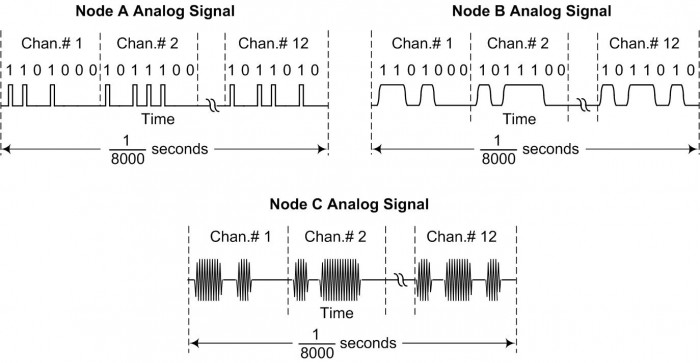A Lesson In Engineering Humility
Let's assume you were given the task to design and build the 12-channel telephone transmission system shown in Figure 1.

Figure 1
At a rate of 8000 samples/second, each telephone's audio signal is sampled and converted to a 7-bit binary sequence of pulses. The analog signals at Figure 1's nodes A, B, and C are presented in Figure 2.

Figure 2
Completing the above task seems almost impossible, particularly the conversion of analog signals into serial streams of binary coded pulses (pulse code modulation, PCM). As it turns out, some clever engineers at Bell Labs actually built such a system as described in the two papers of the PDF file associated with this blog. (The PDF file is 10 Mbytes in size.) Reviewing the electronic wizardry presented in that PDF file is a true lesson in engineering humility.
The Bell Labs papers in the PDF file were published in 1948, the same year as:
* the publication of Claude Shannon's seminal "A Mathematical
Theory of Communication" paper,
* the introduction of the first point-contact transistor,
* the invention of the marshmallow, and
* the birth of yours truly.

PDF File Contents:
L. A. Meacham and E., "An Experimental Multichannel Pulse Code Modulation System of Toll Quality", The Bell System Technical Journal, Vol. 27, No. 1, January 1948, pp. 1-43.
R. W. Sears, "Electron Beam Deflection Tube For Pulse Code Modulation", The Bell System Technical Journal, Vol. 27, No. 1, January 1948, pp. 44-57.- Comments
- Write a Comment Select to add a comment

Rick,
We both witnessed analog signal processing using transistors and simple IC's give way to DSP, which required a lot of technology to come together. In the consumer electronics world, the transition was enabled by cheap data converters, cheap gates and cheap memory.
But your example looks like the Flintstones compared to the technology we worked with. Wooden ships and iron men, as they say.
Neil

So human didn't land on the moon before this digital era...

Hi kaz. Ha ha. No, they sure didn't.

Hi Neil. You're right. That 1948 technology sure looks crude to us by today's standards. But considering what those guys had to work with I thought the PCM implementation using a cathode ray tube was pretty darned slick.
Hey Neil, did you remember the Transistor Sister song?

There was definitely exponential progress from tubes to transistors to 20 nm CMOS integrated circuits. The term "electronics" is applied to all, which is like saying a stage coach and 787 are both "transportation".
I found the song on YouTube. This was from 1961, right about the era portrayed in "American Graffiti". I was too young to remember it -- it was off the charts before transistor radios were common among my age group. I do remember DJ Cousin Brucy on WABC New York.

Hi Rick,
Over this side of the Atlantic, semiconductors had been around for much longer ! Ha Ha
I wonder how technology would have developed if transistors had preceeded vacuum tubes ?
I'll never forget the sheer unreliability of transistors in the 1960s and early seventies, when failure of a component could often result in the failure of anything connected to it. Thermal runaway in audio power transistors meaning they sometimes became "weapons of mass destruction" on a PCB.

If tubes would have appeared after the first generation of transistors ...
If I remember my first experiments with triode tubes (in my teenage years, the mid 70th), I was astonished about the brilliance of the results, compared with the germanium transistors which I had played with.
And the immense amplification! With so few parts! And the linearity! ...
So, I'd assume that the world would have heard a lot of "Aaahs" and "Ohhs" after presentation of the first tube-based amplifiers, because they're so much "better" than the transistor based old ones.
And, it could have slowed down the nowadays rapid development of GaN technology, because another high-voltage-device was already present ;-)

Hi bholzmayer. You wrote: "...and the linearity!" I once read that Rolling Stones guitarist Keith Richards prefers vacuum tube amplifiers over transistor amplifiers.
To post reply to a comment, click on the 'reply' button attached to each comment. To post a new comment (not a reply to a comment) check out the 'Write a Comment' tab at the top of the comments.
Please login (on the right) if you already have an account on this platform.
Otherwise, please use this form to register (free) an join one of the largest online community for Electrical/Embedded/DSP/FPGA/ML engineers:





















